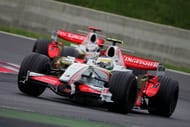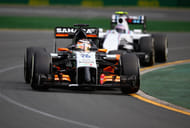Successful stint in F1
Throughout its presence in F1, Force India has consistently performed beyond its capabilities and has challenged more successful rivals in the form of McLaren and Renault (now Lotus) on several occasions. With the kind of budget they operate on, their performances on track are definitely worth being applauded. But the major question is how long can they keep up their form in the highly competitive and expensive world of Formula 1.
The Silverstone based squad has been part of Formula 1 for more than two decades, albeit under different iterations. Even during the 1990s, the team achieved much success as Jordan F1. 1999 was the standout year for them, when they finished third in the Constructors, which was quite an achievement given the private ownership and smaller budget with which the team operated on as compared to other well funded teams like Ferrari, Benetton, Williams, etc. This season was followed by a string of unsuccessful seasons, before financial problems finally took its toll and the team was sold to Midland group in 2005. Midland in turn sold the team in 2006 to Spyker, who too following an unsuccessful season sold the team to a consortium led by Vijay Mallya and Michiel Mol thus giving birth to its current iteration – Force India.

Force India’s journey
During its first season in 2008, the team didn’t achieve much success, but still with drivers of good caliber in the form of Giancarlo Fisichella and Adrian Sutil onboard, hopes were high for the team’s future. Finally in 2009, the team delivered on the potential by securing their first podium, pole position and points finish when Fisichella crossed the line second at the Belgian Grand Prix, which was followed by a fourth place finish by Sutil at the Italian Grand Prix. The old saying of David overpowering Goliath had come true at these races, with the team outclassing other successful and well established rivals.
The following season in 2010 was the year the team finally established itself in the sport. A string of points finishes throughout the season gave the team 68 points and 7th place in the Constructors, thus placing them ahead of both Torro Rosso and Sauber.
The team continued its ascent in 2011 wherein it finished 6th in the Constructors and finished above Williams besides Torro Rosso and Sauber. This year notably the team had a close fight for 5th in Constructors with former world champions’ Renault who had hit a dip in form during the latter half of the season. The team closed the gap to them significantly and by the end of the season, finished just four points behind them.
2012 proved to be one of their best seasons ever with the team crossing 100 points for the first time in its history. But still the team managed only 7th in the Constructors owing to better performances from Sauber who achieved several podiums this year.

Close contest with bigger teams
The team continued to challenge bigger teams and in 2013 had a close fight for 5th in the Constructors with established F1 team McLaren. During the first half of the season, the team managed to stay ahead of Mclaren due to several stellar performances like the 4th place finish at Bahrain by Paul di Resta and the 5th place finish at Monaco by the returnee Adrian Sutil among several others. But in the second half of the season, the team fell behind in the development race which resulted in their finishing behind McLaren in the final standings.
2014 was one of the most radical F1 seasons in history. The introduction of several technical changes this year in the form of V6 engines in place of V8, ERS instead of KERS, and reintroduction of turbocharger after several decades certainly contributed towards mixing up the grid order. Mercedes, interpreting these rules most efficiently, came up with the best power unit while other manufacturers viz. Ferrari and Renault struggled to match their pace.
Missed chances
This year Force India designed a decent car and complemented by an efficient Mercedes engine, the team proved to be one of the surprise package of the season. Their standout race was Bahrain, wherein they secured their first podium since Belgium 2009, when Sergio Perez finished in 3rd place. Surprisingly, after this race, the team found itself 2nd in the Constructors behind Mercedes. After this, Canada proved to be a missed opportunity for them. Here, Perez fought for victory for much of the race despite having braking and power unit problems, being only passed by others with three laps remaining. Unluckily Perez and Massa crashed into each other on the last lap, costing the team a lot of points.
In the latter part of the season, the team again fell prey to lack of development as both McLaren and Williams went ahead of them. During this while, the team was further hurt by dip in form suffered by its driver Nico Hulkenberg. Although the team did recover by the end of the season, but it proved too late as they finished 6th in the Constructors behind McLaren.
Managing resources efficiently
For the past few seasons, the team has consistently performed such a feat, which teams with similar resources have not been able to match. Force India has always run on a medium budget which was around $100 million in 2014. Teams like Sauber and Williams running on a similar budget and resources have not been able to consistently maintain their form, while Force India on the other had has successfully managed it.
In 2011, Renault, which had better budget and infrastructure than Force India, managed to remain just four points ahead of them by the end of the season. Sauber, a team similar to Force India in several aspects produced a better car in 2012 which helped them to achieve four podiums and subsequently finished ahead of Force India in the Constructors. In 2013, McLaren, a well established F1 squad having a budget around £60 million more than Force India, got engaged in a close fight with the latter for 5th place in the Constructors. Force India kept McLaren at bay during the first half of the season, but later due to lack of development of the car, finally McLaren succeeded in finishing ahead of them.
2014 provided a similar story, with Force India again in a close contest with McLaren for fifth in the Constructors. This time, Force India did manage to hold on to fifth in the Constructors for most part of the season, being only passed by McLaren at the 16th round of the season in Russia.
The challenges for the next season
The facts mentioned above clearly describe the consistency in form maintained by Force India through the previous seasons, while it also clearly brings to light the stark difference in performances of other teams like Renault (now Lotus), Williams and Sauber who all have undergone several ups and downs over the past few seasons.
In 2014, the team again proved their mettle, but the challenges in the upcoming seasons are harder than ever. Mercedes and Red Bull with better resources are already ahead in the development race and seem unlikely to be within Force India’s reach. Williams, after almost a decade of dormancy have struck back in form and seem poised to challenge for the Championship rather than fight in the mid-field. Also McLaren with Honda engines, Fernando Alonso and changes in the technical staff seem better placed for next year.
The only big team remaining after them is Ferrari who have endured a dismal 2014 campaign and with key personnel like Alonso, team principal Stefano Domenicali and then his replacement Marco Mattiaci himself being dispatched in November and add to that a deficient machinery, Ferrari seem to be in a weak position. With team principal Maurizio Arrivabene recently appointed and the team undergoing extensive restructure, they are expected to endure a difficult season in 2015, which just might give Force India a chance to again challenge an established F1 squad.

For 2015, Force India has retained its successful driver line-up of Nico Hulkenberg and Sergio Perez. They also have gotten access to the Toyota wind tunnel which might prove instrumental towards improving their aerodynamic potential. Although 2014 could have been better for the team, but nevertheless with the kind of resources they have got, it is really quite remarkable for them to achieve such success. The upcoming season will yet again test the team against well established rivals, with McLaren and Williams seemingly ahead in development; their major ray of hope may lie with Ferrari who are expected to endure another difficult season amid structural changes. But as it stands right now, all of this remains mere speculation, the real grid order will only start coming to light with the beginning of pre-season testing later this month.

